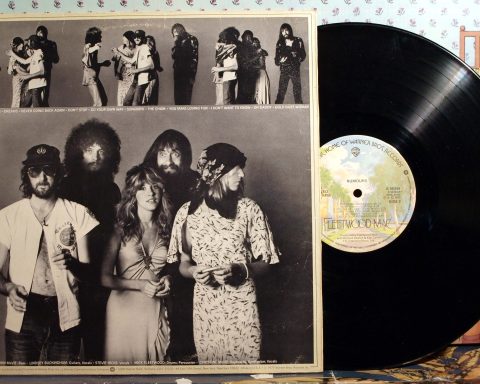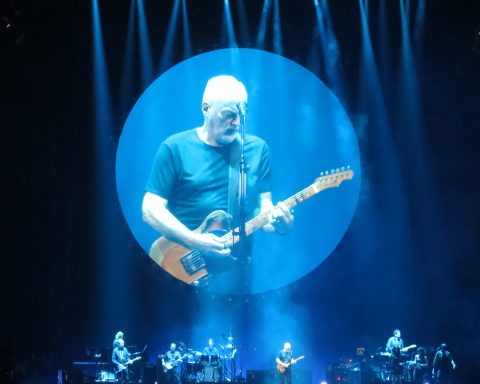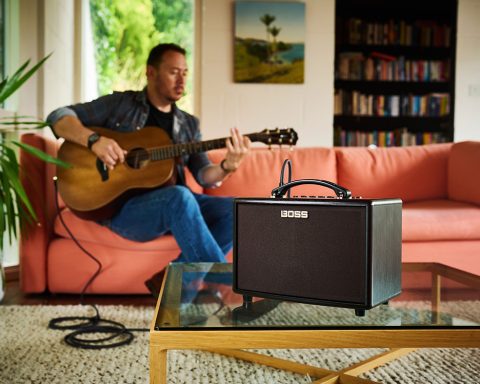There is a slew of questions when one decides to start playing bass. These include which bass amp to buy, what the controls do, and what sounds are necessary. This beginner’s guide covers fundamental bass amp sounds, controls, and tone suggestions based on genre. Throughout, this article will reference the new BOSS Katana-110 Bass amp, a new unit packed with everything needed to succeed in the world of bass.
What Does A Bass Player Do?
Congratulations. Bass players are an essential part of every band. They’re responsible for setting the groove, highlighting changes, and holding it all together. Bassists can add dynamics, change a song’s flow, or maintain it through their choice of notes.
Think of bass players as the sonic lighthouse to which the other musicians look. Whether jamming along to a 12-bar blues, creating a metal masterpiece, or laying down a groove for an MC, bass players must keep the tone and timing solid.
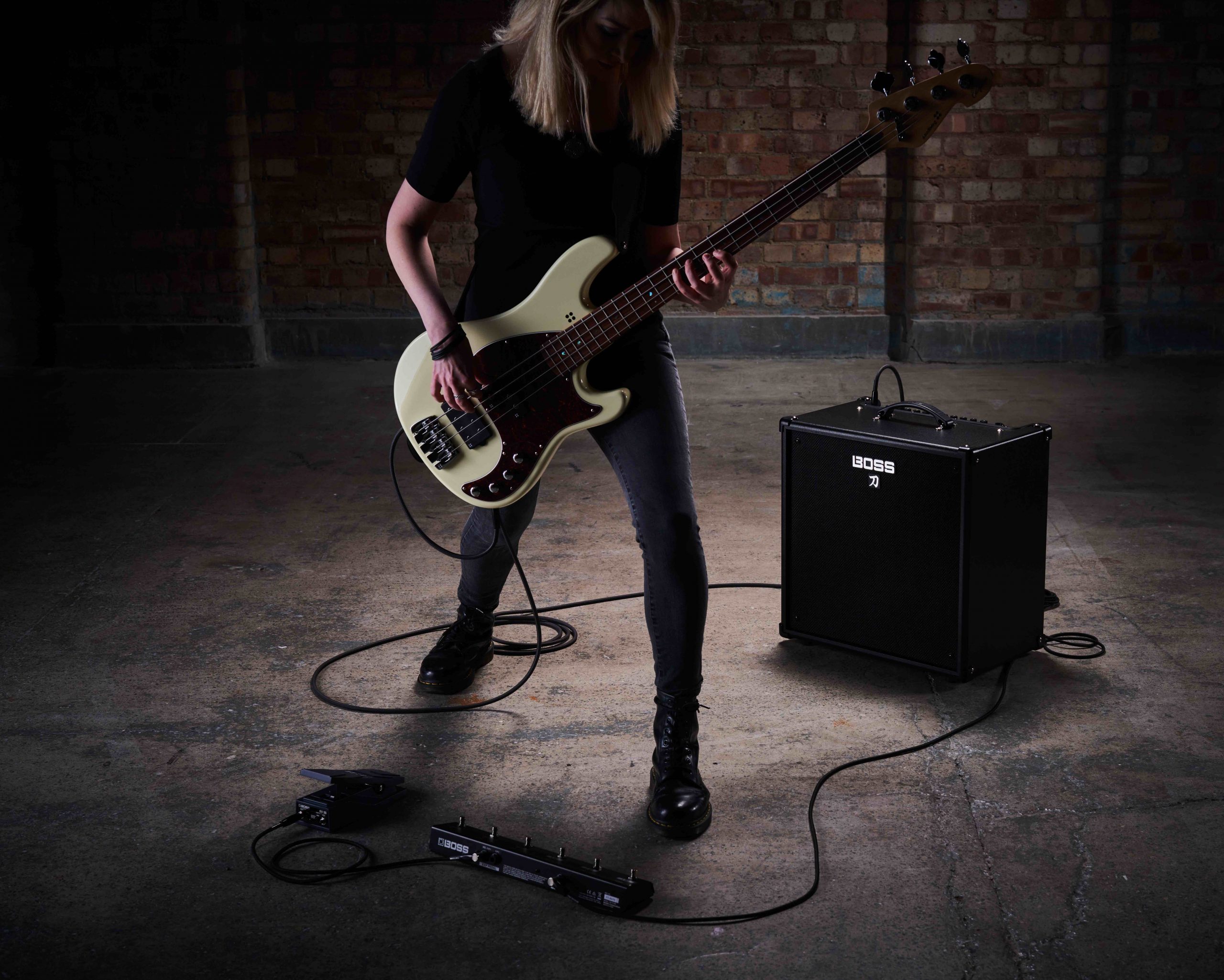
"The way a bassist plays dictates a song’s vibe. In short, bass players have power. "
Setting the Tone
The way a bassist plays dictates a song’s vibe. Dig in and chug and the track will bounce along. Think AC/DC. Starting slow and steady will set a nice groove á la “Walk on the Wild Side” by Lou Reed. Sometimes bass matches the guitar, adding power to the riff while the guitarist hammers out a solo. Rage Against The Machine exemplifies this approach.
Occasionally, bass completely shifts the vibe of the song. On “The Chain” by Fleetwood Mac, John McVie creates an outro that changes the entire direction. In short, bass players have power. Yet the sound needs to be right when holding everything together. An amp helps bring out the best in a song. So where to start with an amp? What are the fundamental sounds a bassist needs?
Bass Amp Controls
So, what do all the bass amp controls do? When thinking about bass amp fundamentals, consider the overall sound and tone.
Looking for a bright, punchy tone? Perhaps something that sits back and keeps a steady groove? The song will dictate the approach, but ideally, an amp will handle everything. In-demand bass players will need a versatile amp to handle different genres.

Nailing bass amp settings will help players sculpt a sound they want. The most common bass amp controls are:
- Volume
- Gain
- Drive
- EQ (Tone)
- Bass
- Treble
- Mids
- Compression
- Blend or Wet/Dry
- FX
What Does Volume Do?
The volume setting of an amp dictates the loudness of the amp in decibels (dB). By increasing the volume, one increases the “loudness” of the amp. This doesn’t necessarily mean the amp sounds better, just louder. If you play badly at a louder volume, more people will hear it.
In general, unless using a tube amp, volume does not affect amp tone. The louder one cranks them, the more of the amp’s character comes out. However, they can be unreliable at higher volumes.
The BOSS original Analog Class AB circuit can reproduce diverse amp behavior—from organic response like a tube amp to tight solid state-sounds. In terms of tube-style tone, the more one cranks it, the more grit they get. The amp growls when a player digs in. Play harder or softer and the amp responds by preserving the dynamics.
"The Katana Bass is a Class AB amplifier that responds almost exactly like a tube amp. The more one cranks it, the more grit they get."
What Does Gain Do?
Almost all bass amplifiers have a gain control. This is sometimes labeled drive or distortion. If the amp has two of the three, they are usually gain and drive as these are two separate controls.
Gain is the signal intensity. This is the power and intensity of the signal from the bass. Increasing the gain means increasing the power of the signal coming into the amp. Think of gain as a foundation of the sound. If the gain is up, the foundation has a grittier sound. Dial the gain back and there is a cleaner foundation.
Gain Tips
- Turn the gain up and the amp will start to break up, providing some nice grit. Everything will have more aggression.
- Turn the gain down and the volume up, and the amp will clean up, providing a purer tone.
- Gain adds power and responds to a player’s dynamics. The harder one plays, the more the amp will break up. The softer one plays, the less gritty the amp will sound.
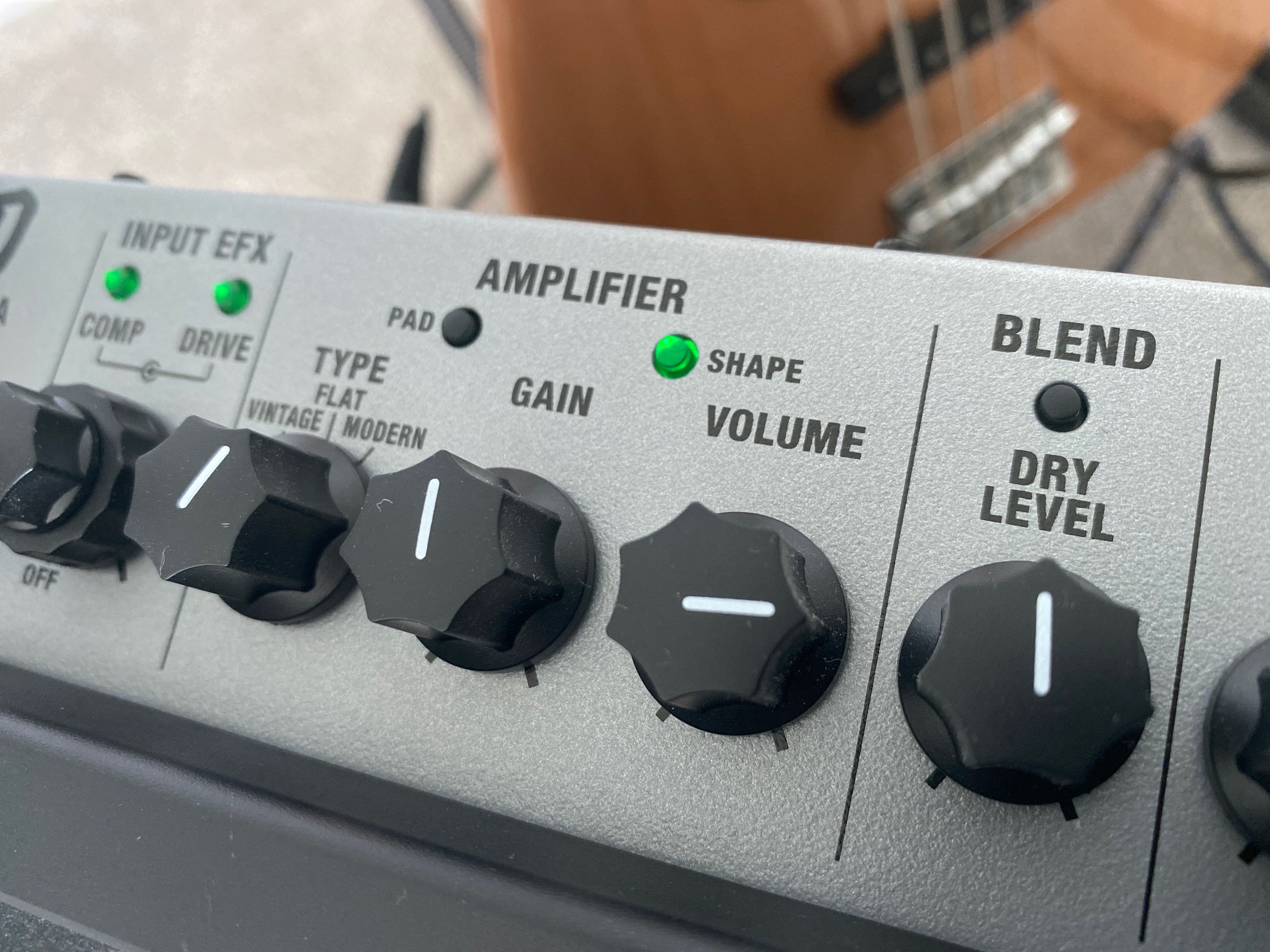
What Does Drive Do?
Drive is sometimes labeled distortion. Unlike gain, when using a distortion pedal or a distortion effect, it’s always on. No matter how hard or soft one plays. Drive takes an existing signal and paints over it.
Often, bassists use drive instead of gain. This is the case when players want a clean tone for most of the song but distortion when needed. For example, a verse might require a clean tone, while the chorus needs more punch. One can use a pedal to turn the drive on and push the song. Drive is great for adding extra power during a chorus section.
"With the Katana Bass, you can achieve a classic drive sound at lower volumes."
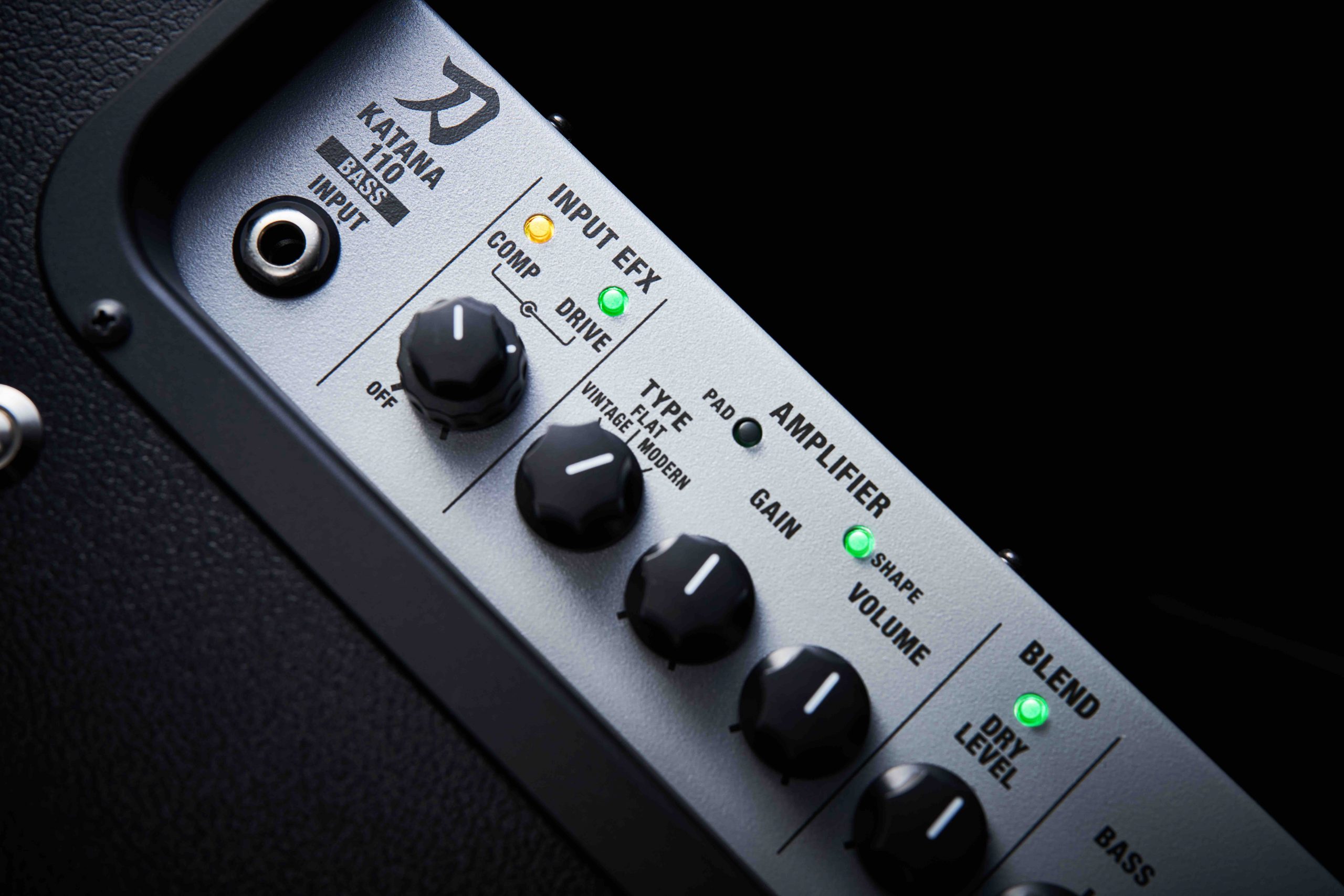
With the Katana Bass, you can achieve a classic drive sound at lower volumes. The master volume allows players to turn the bass amp down while turning the gain and drive up. This ensures a distorted or overdriven sound at lower volumes. The attenuation/wattage selector allows for the organic flavor and response of a 110 or 300-watt amp at a mere 1 watt. Select the amp volume and increase the drive or gain effect.
EQ or Tone
All bass amps will have a Tone section, often labeled as EQ or Equalizer. This is where bass players sculpt the controls of their amp and create a signature sound by toggling the treble, mids, and bass.
The EQ section allows players to add more bass and weight to the sound. Alternatively, they can make their bass sound brighter and bring out the clarity of the bass playing. Some bass guitar amps only have a bass and treble knob that cuts or boosts these signals. Others might boast a plethora of different dials. Bass, low-mid, high-mid, and treble are the four main EQ zones to know.
"The EQ section allows players to add more bass and weight to the sound."
Bass
The bass knob on a bass amp allows one to adjust the low-end frequencies. This is where one gets the depth and weight of the sound. Start at 12 o’clock, then reduce or increase until reaching the desired amount of bass character.
More bass can sometimes add muddiness to the sound. Try and place the amp on a stand to ensure the sound doesn’t get absorbed into the floor. More bass doesn’t mean more power. That’s where the mids come in.
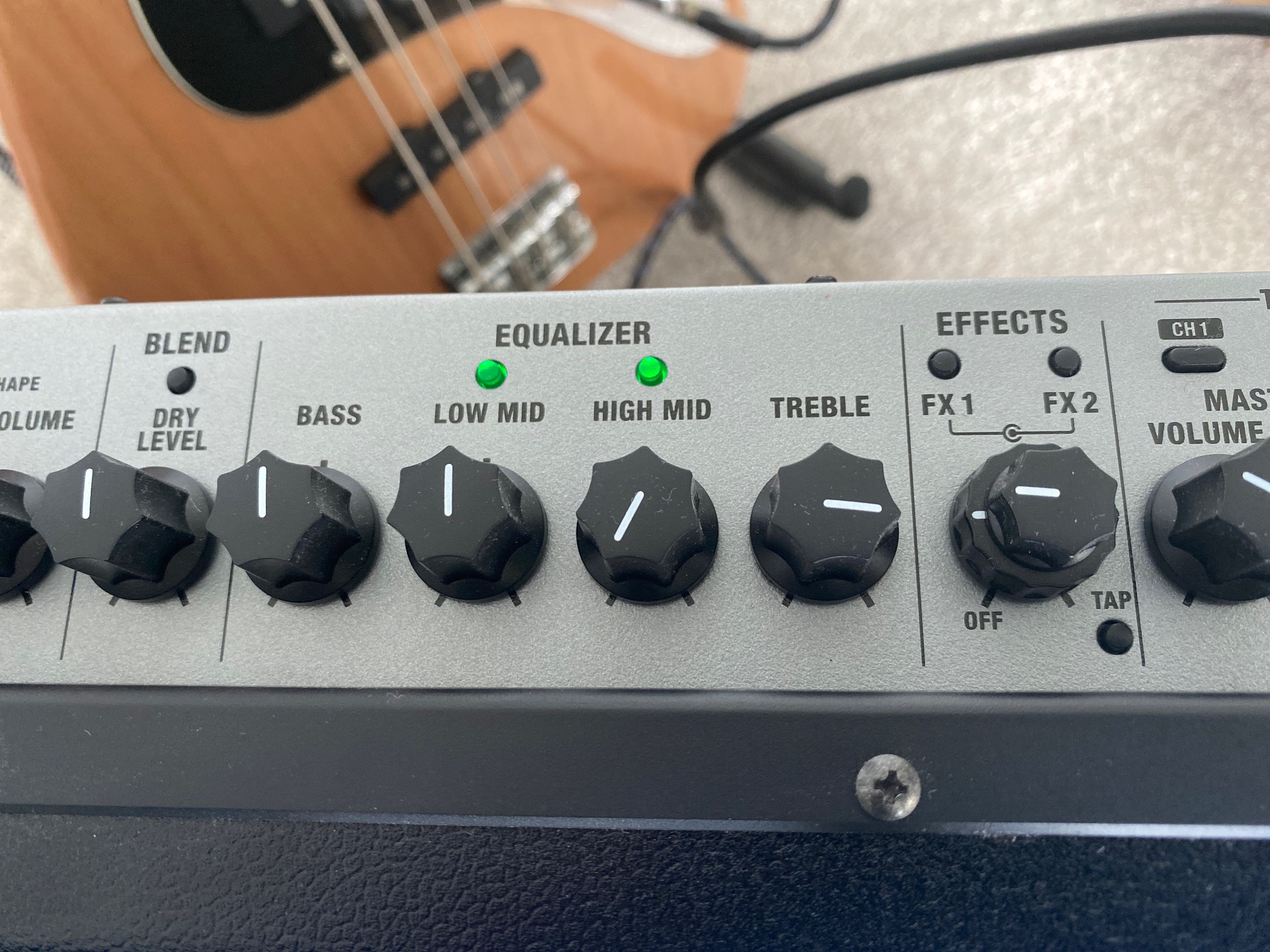
Low-Mids and High-Mids
This is where all the punch and detail in bass sound come from. Amps with both controls rather than a single mid control have parametric EQ. These are very useful for a bass player to get right as the human ear hears the midrange frequencies more in a mix. Turning up the midrange or boosting the midrange turns up the detail. It’s the most crucial aspect of a bass amp sound as it’s the most honest representation of a bass guitar.
The low-mid setting is where one can boost the beefiness of the tone without adding more bass and losing detail. Often players who use their fingers will increase the low-mids.
"The low-mid setting is where one can boost the beefiness of the tone without adding more bass and losing detail."
The high-mid setting is where one can boost the high-end sound without adding too much treble or letting the sound become harsh. Crank the high-end mid without adding treble, and the amp will start to sound muffled. So turn the high-mid down and slowly increase treble for that added detail. Players who use a plectrum will often turn up the high mids. This sound responds nicely to the attack from a pick.
Treble
Treble represents the high-end frequencies. This is the sparkle or guitar-like sound of the bass. Start with the treble at zero and slowly turn it up to see where you like the sparkle of your sound. If you want a brighter, higher-pitched sound, boost the treble. If you want a darker sound, reduce the treble. It’s easy to edit the mids and frequencies using the BOSS Tone Studio. Click on EQ and try it out.

A great example of a high treble sound is the bass line in the Killers, “Jenny Was A Friend Of Mine.” Listen to the intro from 22 seconds into the song.
EQ Tips
One can edit the mids sections and frequencies using the BOSS Tone Studio. Click on EQ and get to work. In summary, break down the EQ settings on a bass guitar amp as follows:
- Bass: The low-end boom
- Low-Mid: Punch and clarity
- Hi-Mid: Snap and attack
- Treble: High-end pitch and brightness
Here is a tip when equalizing a bass amp and dialing in a tone for the first time. Start with bass and treble set to zero and sculpt the mid tones first. This will ensure the detail is there. Then add more bass to add power. Once the power from the bass sounds right, adjust the treble to get some sparkle and presence. Adjust to taste.
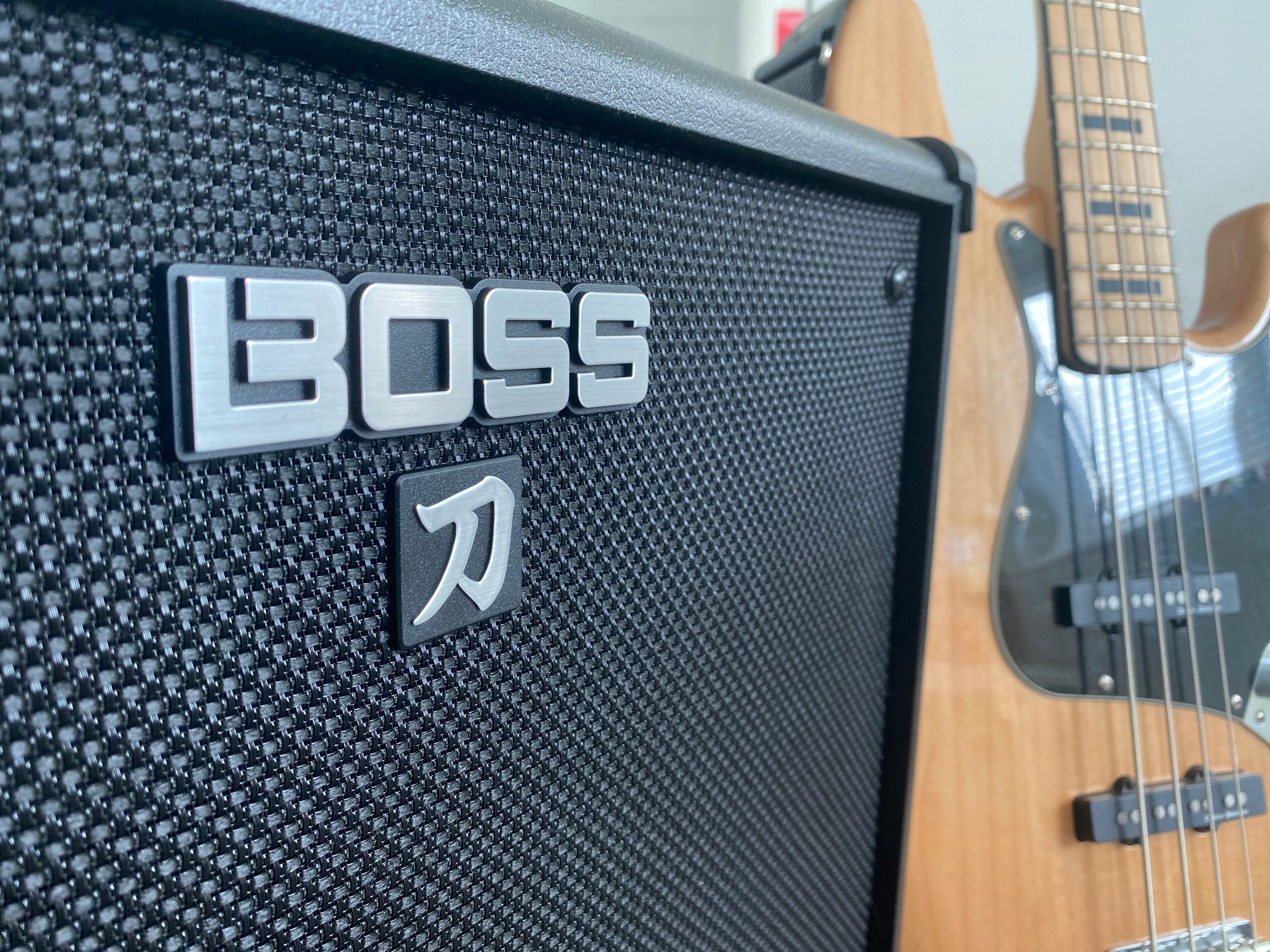
Bass Amp Compression
Compression is a fundamental feature of a bass amp’s tone and one of the main controls found on a bass amp. Simply put, compression evens out tone so all notes are equal. It makes louder notes quieter and quieter notes louder. Compression removes any dead spots and ensures each note is clear and accurate. Basically, the effect makes each note more present.
Benefits of Compression
As a bass player, some notes can get lost in the mix when playing with a band. Compression helps solve that problem by ensuring each note is even. When using distortion or drive on a bass amp, compression can be very useful. It encourages louder notes to clip when you play the string harder. However, this doesn’t increase the volume of the note. For a deep dive into compression and other effects, read “Order of Operation: A Guide to Bass Effects Signal Chain.”
"Some notes can get lost in the mix when playing with a band. Compression helps solve that problem."
Dialing in Compression
When experimenting with compression, focus on the attack section first. This part dictates at which point the compression starts to work, also known as the reaction time. For example, with the attack low, the compression won’t catch the sound and the different levels and dead spots will be more present. However, with attack high, the compressor will catch uneven notes early and bring the sound to an even setting.

The Katana-110 Bass allows users to toggle the compression effects on/off via the GA-FC footswitch. Set compression either on the panel of the amplifier or edit a bank within BOSS Tone Studio. Stomp on CH1/ Comp to turn it on and off. Players can set the section to use three different types of compression, three different types of limiters, or a mixture. Go to EDIT and toggle the options on the left.
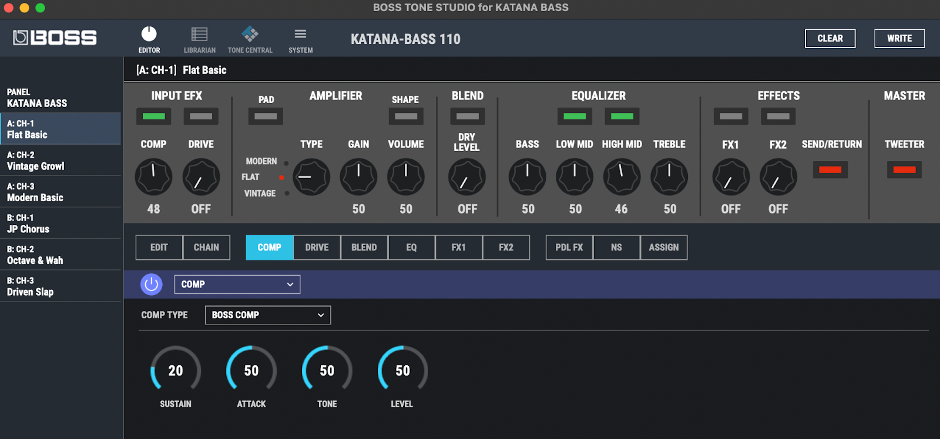
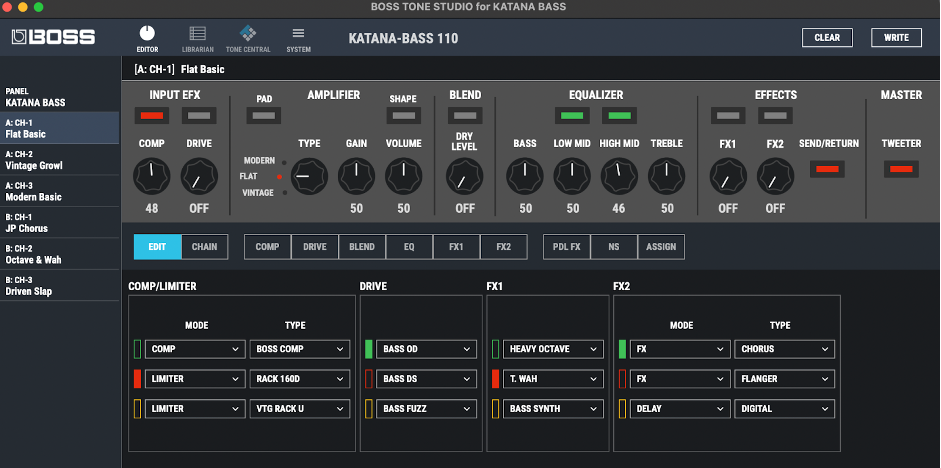
Blend Setting
The Blend control on a bass amp affects the wet/dry signal of the bass. The wet signal has effects on it, while the dry signal is just the bass and amp without effects. Sometimes it’s beneficial to preserve the clean, dry tone of a bass. Amps with this feature allow players to keep the full weight of the bass guitar sound and add effects alongside it. The Blend control on the Katana-110 Bass adds an amount of dry signal into an amp tone. This retains the qualities and power of the bass tone while using effects.
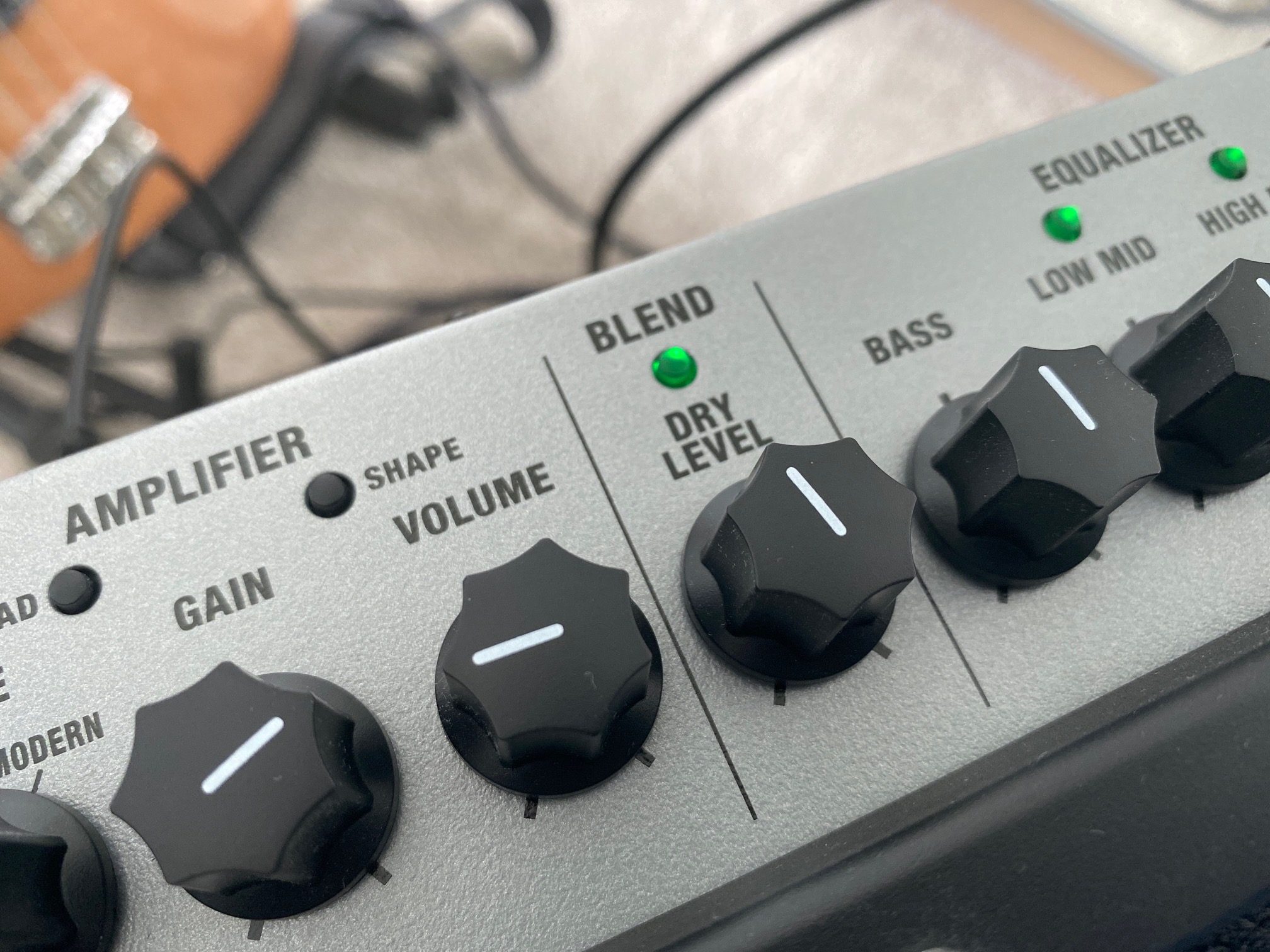
Amp Type Setting on a Bass Amp
Tube amps use tubes to get their powerful, organic sound. They are louder, heavier, and less reliable. Solid-state amps use transistors rather than glass tubes. They are lighter in weight, can be just as loud, but may offer fewer dynamics and a less organic feel.
.
Some bass players love tube amps. Increasing the volume of a tube amp causes the amp to drive harder as you push the tubes into saturation. This adds more grit. Other bass players prefer the reliability and cleanness of a solid state amp. Increasing the volume of a solid state amp creates a louder signal. This is especially useful for a clean sound at higher volumes. Finally, some bass players prefer to DI their bass for a pure tone. Jazz musicians prefer this as it is an unprocessed and direct representation of bass.

Have it All with Katana Bass
Why not have all three options? Enter Tube Logic technology. The Katana-110 Bass has three selectable amp voicings covering a range of styles. This setting offers the ability to toggle between a balanced and natural tone, an organic drive, or a solid-state option. The third choice provides higher-end frequencies and high-gain clarity
Flat
Using this voicing gives a smooth, clear, and dynamic tone with rich harmonics and a balanced, natural sound. Flat is the foundational tone that preserves the quality of your bass guitar.
Vintage
This amp voicing provides a classic tube voice with a well-rounded tone and natural drive. Play softer, and the amp will chill out; play harder, and the amp will start to growl. The Tube Logic technology ensures tube-like response with solid-state reliability.
Modern
Try the Modern amp type for contemporary, progressive bass tones. This type offers a dynamic response for heavy rock riffs and extended-range instruments, like five and six-string basses.
"Katana Bass offers the ability to toggle between a balanced and natural tone, an organic drive, or a solid state option."
Pad Setting
Bass guitars with powered pickups send a stronger signal to the bass amp. If the signal is too loud, then the amp is hard to control and dynamics go out the window. A pad setting allows bassists to drop the input sensitivity by -10dB, which is great for high-output basses. This works best for basses with powered pickups, making it perfect for metal players.
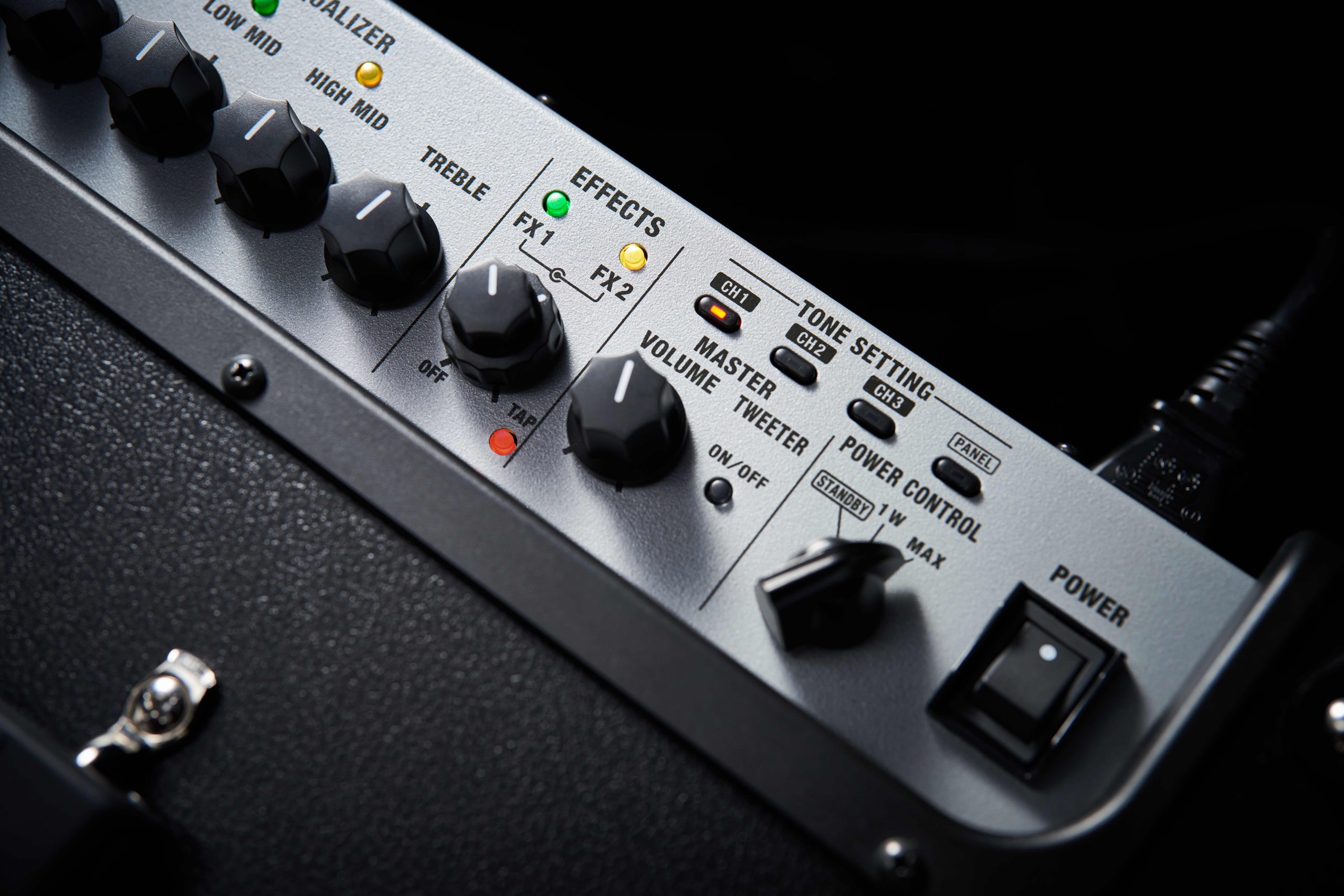
Shape Control
A shape control is an incredible tool. Boost certain frequencies at the touch of a button and revert to original settings when finished. A shape feature is especially useful in bridge or pre-choruses to build tension. The Shape button on the Katana-110 Bass, for example, switches tone characters from low boost, high boost, and low and high boost together.
"Chorus thickens up bass tone by doubling up the signal. With chorus on, it sounds like two bass guitarists playing the same thing."
Common Bass FX
Modulation
Modulation is one of the main effects found in bass rigs, specifically chorus. On modeling bass amps or bass amps with built-in effects, some modulation helps fatten up the tone. Chorus, flanger, and phaser all fall under the modulation category. They are some of the most common effects found on a bass player’s effects list.
Chorus
Chorus thickens up bass tone by doubling up the signal. With chorus on, a bass part can sound like two bass guitarists playing the same thing. However, there will be subtle pitch differences. Listen to Alice in Chains or “Waterfall” by Stone Roses to hear bass chorus in full effect.
Phaser/Flanger
Phasers and flangers are very similar. Phasers add a smooth sweeping sound to a signal, whereas a flanger is much more intense. The latter produces a psychedelic, swishing noise that helps bass stand out. Phil Lynott of Thin Lizzy used this type of modulation on “Waiting for an Alibi” and “Dancing in the Moonlight.”
The Katana-110 Bass has both these as well as 60 customizable effects taken from the BOSS repertoire of pedals and rack-mounted units. Head over to FX1 or FX2 in the BOSS Tone Studio to select a full range of modulation options.
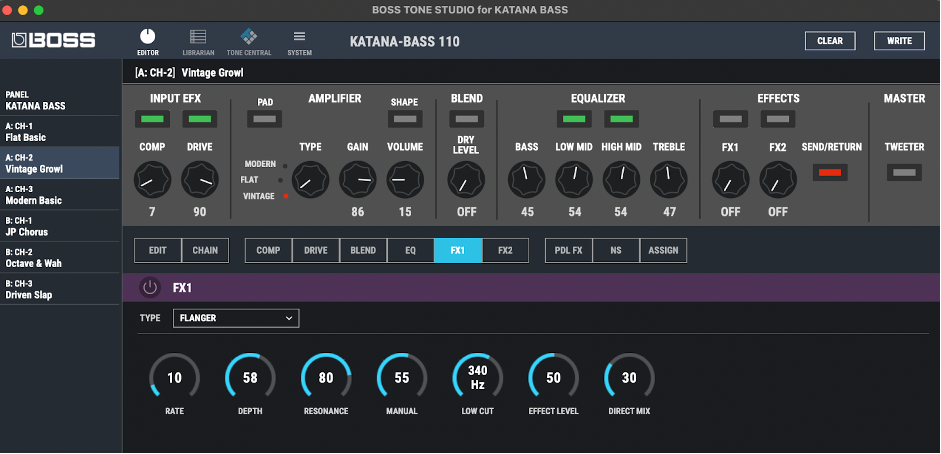
Guitar Amps Versus Bass Amps
So, what are the main differences between a guitar amp and a bass amp? They come down to speaker size, power output, onboard features, and frequency range.
Bass amps use the low, very low, and low-mid range of frequencies that a bass guitar needs to stand out. They preserve the low end of the bass sound so listeners can hear it. These speakers are also designed to push a lot more air around. Bass amps will always have a bass speaker which uses a woofer and a tweeter. They pack a lot more power than a guitar amp to compensate for this.
Guitar amps preserve and accentuate the mid and mid-high frequencies of a sound. They often have more effects, EQ settings, preamp settings, and lower power output. Also, their speakers cater to higher frequencies.
"Differences between guitar amps and bass amps come down to speaker size, power output, onboard features, and frequency range."
More Tone Options with Katana Bass
Katana Bass breaks the bass amp mold. In fact, it provides more choice than any other bass amp available and more than many guitar amps. There is a custom bi-amp system with a custom 2-way speaker system. It allows players to activate the tweeter for higher frequencies or deactivate it for low notes. Choose 110 watts with the Katana-110 Bass which utilizes a single 10” speaker. Or go with 300 watts with the Katana-210 Bass which utilizes 2 x 10″ speakers for added presence and power.
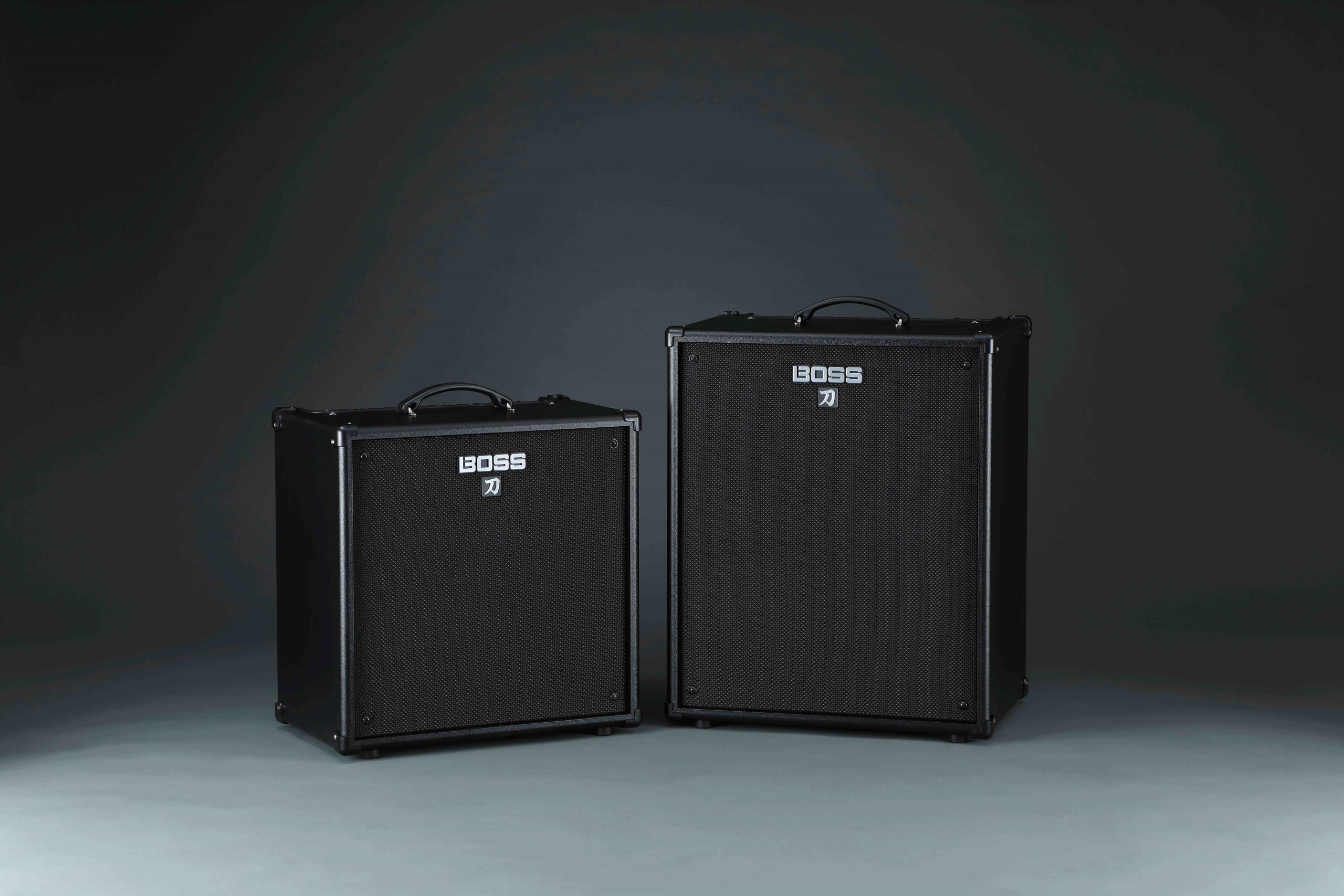
"Katana Bass is like taking a complete studio’s worth of effects and bass amps to the gig."
The Katana Bass series includes everything above and more. This includes three amp types and over 60 effects. There is also a power control to drive tone at lower volumes and the ability to store six customizable presets via the BOSS Tone Studio. It’s like taking a complete studio’s worth of effects and bass amps to the gig. So get out there and start pumping that low end.




